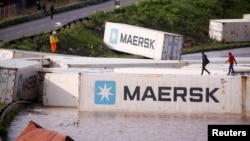JOHANNESBURG — Some of the worst flooding in South Africa’s history has left more than 400 people dead and some 40,000 displaced, dealing a devastating blow to the eastern city of Durban, which has a seaport that has also been badly affected.
With the port not fully functioning, there are supply chain concerns and China — South Africa’s biggest trading partner — and other nations, are likely to see their imports and exports disrupted.
Earlier this week, South African President Cyril Ramaphosa declared a national state of disaster because of the flooding — which he blames on climate change but which some critics blame on poor infrastructure and the fact that most of the people affected were living in makeshift shacks in informal settlements.
Ramaphosa stressed the importance of quickly fixing the situation at the port, saying, “The Port of Durban — which is one of the largest and busiest shipping terminals on the continent and which is vital to our country’s economy — has been severely affected.”
The road to the port, which handles some 13,000 heavy vehicles a day, has been severely damaged, he added.
On Tuesday, Public Enterprises Minister Pravin Gordhan Pravin Gordhan visited the port, which has reopened, and concluded it would take more a week to clear some backlogs. The rail network to the site had been affected by landslides and still needs to be repaired, he said, adding that 9,000 containers have accumulated at the port and would be cleared in the next nine days.
Logs and debris also ended up in the harbor due to the floods, which he said had disrupted shipping.
One of the countries likely to be affected by problems at the port is China, said Cobus van Staden, senior China-Africa researcher at the South African Institute of International Affairs.
“In relation to the situation in Durban, it’s very serious for the whole of China-Africa trade, rather than just for South Africa; this is because of the centrality of Durban port to Chinese exports,” he told VOA.
“About 20 percent of total China-Africa trade goes out through Durban and this includes resources like cobalt, copper and lithium coming from the Democratic Republic of Congo and Zimbabwe particularly,” he added.
Maersk, the world’s biggest container line, halted operations at the port last week and told VOA by email its warehouse had been affected and was still not operational. While vessel operations had resumed, the company said problems with road access were affecting all cargo entering or leaving the terminal.
“We continue to assess the damages and monitor the situation as it evolves, customers are being updated daily on the progress and the contingency plans so that we may get the supply chains moving again as quickly as possible,” it said.
Wandile Sihlobo, chief economist for the Agricultural Business Chamber of South Africa, told VOA he thought it would take some time before activities at the port were back to normal.
“There’s been great devastation by these excessive rains and it’s a major risk to commerce and all goods: automobile, agriculture and other sectors of the economy that are dependent on trade,” he said.




